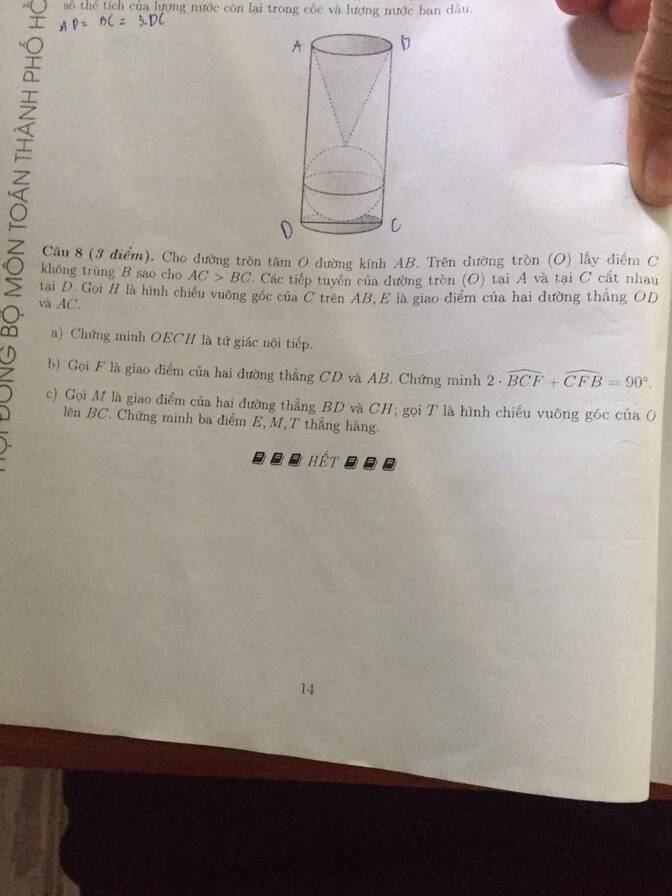gi
giải dùm mình câu c hình với ạ

Hãy nhập câu hỏi của bạn vào đây, nếu là tài khoản VIP, bạn sẽ được ưu tiên trả lời.


`(1+2cosx)(3-cosx)=0`
\(\Leftrightarrow\left[{}\begin{matrix}cosx=-\dfrac{1}{2}\\cosx=3\left(L\right)\end{matrix}\right.\\ \Leftrightarrow\left[{}\begin{matrix}x=\dfrac{2\pi}{3}+k2\pi\\x=\dfrac{-2\pi}{3}+k2\pi\end{matrix}\right.\\ \Leftrightarrow x=\dfrac{2\pi}{3}+k\pi\)
`(k \in ZZ)`
\(\Leftrightarrow\left[{}\begin{matrix}1+2\cos x=0\\3-\cos x=0\end{matrix}\right.\)
\(\Leftrightarrow\left[{}\begin{matrix}\cos x=-\dfrac{1}{2}\\\cos x=3\end{matrix}\right.\)
Mà \(-1\le\cos x\le1\)
\(\Rightarrow\cos x=-\dfrac{1}{2}\)
\(\Rightarrow\left[{}\begin{matrix}x=\dfrac{2}{3}\pi+k2\pi\\x=\dfrac{4}{3}\pi+k2\pi\end{matrix}\right.\)
Vậy ...

5/ \(10x+3-5x\le14x+12\)
<=>\(10x-5x-14x\le12-3\)
<=>\(-9x\le9\)
<=>\(x\ge-1\)
Vậy bất phương trình có nghiệm là \(x\ge-1\)
6/\(\left(3x-1\right)< 2x+4\)
<=>\(3x-2x< 4+1\)
<=> x<5
Vậy tập nghiệm của bất phương trình là x<5

5.
ĐKXĐ: \(cos\left(x-30^0\right)\ne0\Leftrightarrow x\ne120^0+k180^0\)
Pt tương đương:
\(\left[{}\begin{matrix}tan\left(x-30^0\right)=0\\cos\left(2x-150^0\right)=0\end{matrix}\right.\)
\(\Leftrightarrow\left[{}\begin{matrix}x-30^0=k180^0\\2x-150^0=90^0+k180^0\end{matrix}\right.\)
\(\Leftrightarrow\left[{}\begin{matrix}x=30^0+k180^0\\x=120^0+k90^0\end{matrix}\right.\)
Kết hợp ĐKXĐ: \(\Rightarrow x=30^0+k180^0\)
6.
\(\Leftrightarrow2\sqrt{2}sinx.cosx+2cosx=0\)
\(\Leftrightarrow2cosx\left(\sqrt{2}sinx+1\right)=0\)
\(\Leftrightarrow\left[{}\begin{matrix}cosx=0\\sinx=-\dfrac{\sqrt{2}}{2}\end{matrix}\right.\)
\(\Leftrightarrow\left[{}\begin{matrix}x=\dfrac{\pi}{2}+k\pi\\x=-\dfrac{\pi}{4}+k2\pi\\x=\dfrac{5\pi}{4}+k2\pi\end{matrix}\right.\)

Do M thuộc d nên tọa độ có dạng: \(M\left(2t-1;t+1\right)\)
\(\Rightarrow\overrightarrow{OM}=\left(2t-1;t+1\right)\Rightarrow OM=\sqrt{\left(2t-1\right)^2+\left(t+1\right)^2}\)
\(OM=\sqrt{5t^2-2t+2}=\sqrt{5\left(t-\dfrac{1}{5}\right)^2+\dfrac{9}{5}}\ge\dfrac{3}{\sqrt{5}}\)
Dấu "=" xảy ra khi \(t-\dfrac{1}{5}=0\Rightarrow t=\dfrac{1}{5}\Rightarrow M\left(-\dfrac{3}{5};\dfrac{6}{5}\right)\)
Đáp án của bài toán bị sai (nhầm dấu hoành độ)


Bài 5:
a: 2x-(3-5x)=4(x+3)
=>2x-3+5x=4x+12
=>7x-3=4x+12
=>3x=15
=>x=5
b: =>5/3x-2/3+x=1+5/2-3/2x
=>25/6x=25/6
=>x=1
c: 3x-2=2x-3
=>3x-2x=-3+2
=>x=-1
d: =>2u+27=4u+27
=>u=0
e: =>5-x+6=12-8x
=>-x+11=12-8x
=>7x=1
=>x=1/7
f: =>-90+12x=-45+6x
=>12x-90=6x-45
=>6x-45=0
=>x=9/2

1.\(x^2+4x+4=\left(x+2\right)^2\)
2.\(x^2-8x+16=\left(x-4\right)^2\)
3.\(\left(x+5\right)\left(x-5\right)=x^2-25\)
4.\(x^3+12x+48x+64=\left(x+4\right)^3\)
5.\(x^3-6x^2+12x-8=\left(x-2\right)^3\)
6.\(\left(x+2\right)\left(x^2-2x+4\right)=x^3+8\)
7.\(\left(x-3\right)\left(x^2+3x+9\right)=x^3-27\)
8.\(4x^4-15=\left(2x^2\right)^2-\left(\sqrt{15}\right)^2=\left(2x^2-\sqrt{15}\right)\left(2x^2+\sqrt{15}\right)\)